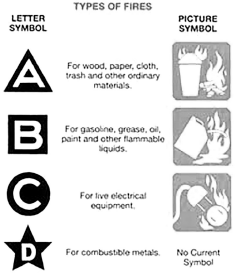Fire classes are arranged according to materials that burn similarly. The four classifications of fires are:
Class A – Ordinary Combustibles
Class B – Flammable Liquids
Class C – Electrical Equipment
Class D – Combustible Metals

Class A: Ordinary Combustibles
Class A fires are fuelled by wood, paper, cloth, and plastic. Water is one of the best extinguishers for this class of fire.
Class B: Flammable Liquids
Class B fires are fuelled by gasoline, grease, paints, oils, and other liquids. With these types of fires, usually only the vapour on top of the liquid is actually burning so once the flame is extinguished, the fire will go out. This can be accomplished by smothering the flame with non-flammable material such as foam, powder, soda, or sand.
DO NOT USE WATER on Class B fires. Most combustible liquids will float on the water and the flames may spread rather than be extinguished.
CAUTION: Watch for Re-ignition with Materials in this Class.
Class C: Electrical Equipment
Class C fires occur on live electrical equipment. Again, as in Class B, fires should be controlled with non-flammable smothering such as CO2 or dry chemicals.
DO NOT USE WATER on Class C fires. There is danger from electrical shock when water and electricity are mixed.
Class D: Combustible Metals
Class D fires occur with combustible metals, such as burning magnesium shavings.
Again, as in Class B and Class C, fires should be controlled with non-flammable smothering such as CO2 or dry chemicals.
